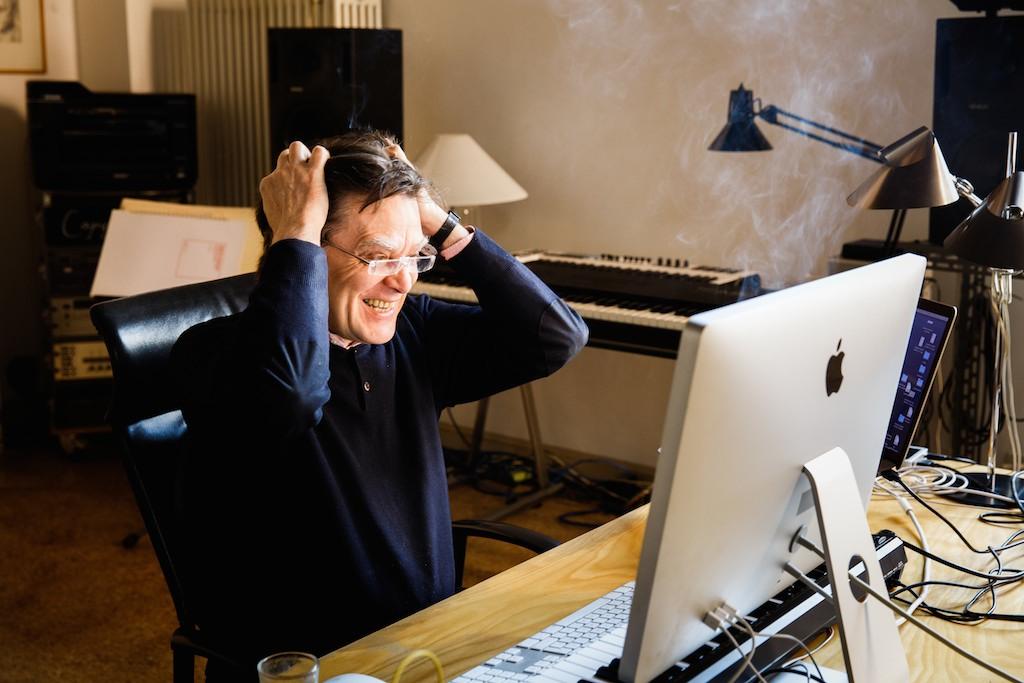-
Posts
2,894 -
Joined
-
Last visited
Reputation Activity
-

-
 opmo reacted to Stephane Boussuge in I can hear the wind Trio
opmo reacted to Stephane Boussuge in I can hear the wind Trio
Hi,
a new test piece made with my template Trio "Infinite Variations"
Trio - I can hear the Wind.mp4
i can hear the wind.opmo
-
 opmo reacted to Stephane Boussuge in mapping attributes to Note Length
opmo reacted to Stephane Boussuge in mapping attributes to Note Length
Another solution is also possible with the function length-map:
(setf omn '((q e3 p -q s a4) (s f3 mp -s) (e g3 mf))) (setf out (length-map '((q ord)(s stacc)(e spicc)) omn)) => ((q e3 p ord - s a4 stacc) (s f3 mp stacc -) (e g3 mf spicc))
-
 opmo reacted to ArthurStammet in Needing 2 supplementary licences
opmo reacted to ArthurStammet in Needing 2 supplementary licences
Many thanks,
it's already done!!!!!!!
seen your "Done" just after my submission
Great.
Just tested my activation on my PC. It works like a charm.
Many thanks for your reactivity.
Let's try on this new dimension...
-
 opmo got a reaction from TomTolleson in length-augmentation to fill rests
opmo got a reaction from TomTolleson in length-augmentation to fill rests
(setf aug-rest-length (loop for i in (omn :length mat) when (length-restp i) collect (* 1/2 i) when (length-notep i) collect (* 2 i)))
or
(setf aug-rest-length (loop for i in (omn :length mat) when (minusp i) collect (* 1/2 i) when (plusp i) collect (* 2 i)))
-
 opmo got a reaction from TomTolleson in length-augmentation to fill rests
opmo got a reaction from TomTolleson in length-augmentation to fill rests
(setf mat (flatten '((s d3 ffff -e. s f3 mf -q.. s f3 ffff -e.) (s g3 -e. s f3 -e. q.. g3 -s)))) (setf aug-length (loop for i in (omn :length mat) collect (if (length-restp i) i (car (length-augmentation 4 (list i)))))) (setf augmat (make-omn :length aug-length :pitch (omn :pitch mat) :velocity (omn :velocity mat) :articulation (omn :articulation mat))) (setf mat (pitch-transpose -12 augmat)) => (q d2 ffff -e. q f2 mf -q.. q f2 ffff -e. q g2 -e. q f2 -e. w.. g2 -s)
-
 opmo got a reaction from Stephane Boussuge in length-augmentation to fill rests
opmo got a reaction from Stephane Boussuge in length-augmentation to fill rests
(setf mat (flatten '((s d3 ffff -e. s f3 mf -q.. s f3 ffff -e.) (s g3 -e. s f3 -e. q.. g3 -s)))) (setf aug-length (loop for i in (omn :length mat) collect (if (length-restp i) i (car (length-augmentation 4 (list i)))))) (setf augmat (make-omn :length aug-length :pitch (omn :pitch mat) :velocity (omn :velocity mat) :articulation (omn :articulation mat))) (setf mat (pitch-transpose -12 augmat)) => (q d2 ffff -e. q f2 mf -q.. q f2 ffff -e. q g2 -e. q f2 -e. w.. g2 -s)
-
 opmo reacted to larsr in Error after completing purchase
opmo reacted to larsr in Error after completing purchase
Thank you opmo.
It all seems to work now.
I really look forward to familiarise myself with the intricate details of this system. I have written some very specialised code for working with harmony, intervals and progressions, written in c++, that I now have a great reason to port to common lisp, a language I studied a lot in the past and find almost perfect for capturing knowledge.
Best regards
Lars
-
 opmo reacted to Stephane Boussuge in Output example from 5 OM Lessons: Score175-90884 and Score175-922647
opmo reacted to Stephane Boussuge in Output example from 5 OM Lessons: Score175-90884 and Score175-922647
2 possible output from my Score175 algorithm direct from Opusmodus without any edit (OM drive VSL in VEPro).
This is an example of what you can do with good understanding of lessons 1 and 3 from my new course "5 Opusmodus Lessons" on composer workshop.com
S.
Score175-90884.mp3
Score175-922647.mp3
-
 opmo reacted to Stephane Boussuge in Strange attractor for Ensemble (Note Performer render)
opmo reacted to Stephane Boussuge in Strange attractor for Ensemble (Note Performer render)
Hi,
here's the Note performer rendering of Strange attractor for Ensemble.
stephaneboussuge · Strange attractor
-
 opmo reacted to Stephane Boussuge in Video - Strange attractor for ensemble
opmo reacted to Stephane Boussuge in Video - Strange attractor for ensemble
New piece composed with the technique used in Composerworksop course: 5 Opusmodus lessons.
-
 opmo reacted to Stephane Boussuge in New course on Composerworkshop and November sales - 20%
opmo reacted to Stephane Boussuge in New course on Composerworkshop and November sales - 20%
Hi folks,
I am thrilled to unveil my latest course offering on Composerworkshop.com, entitled "5 Opusmodus Lessons."
Spanning over 50 instructional videos, these five lessons delve into the sophisticated capabilities of Opusmodus, equipping you with powerful algorithms that will enhance your compositional process.
You’ll learn how to generate and manipulate a limitless stream of music, all while maintaining control over every aspect.
Take advantage of an exclusive offer starting today until the 24th of November. Enjoy a 20% discount on all video packages, including this brand-new course, by using the promo code "friday20" at checkout.
Stephane
-
 opmo got a reaction from JulioHerrlein in Tuplet organization
opmo got a reaction from JulioHerrlein in Tuplet organization
Fixed in 3.0.29130
'((3h c4 e4 g4 h c4e4g4b4) (-q q c5 3h a4 g4 e4))
-
 opmo reacted to JulioHerrlein in Video about 5-note voicings with drop-voicing function (in portuguese) - Julio Herrlein
opmo reacted to JulioHerrlein in Video about 5-note voicings with drop-voicing function (in portuguese) - Julio Herrlein
Video about 5-note voicings with drop-voicing function (in portuguese)
-

-

-
 opmo got a reaction from JulioHerrlein in Some differences in the new interface
opmo got a reaction from JulioHerrlein in Some differences in the new interface
Most of the users were asking about alphanumerical sort. This is what we did adding numerical sort as well.
-
 opmo got a reaction from JulioHerrlein in Some differences in the new interface
opmo got a reaction from JulioHerrlein in Some differences in the new interface
The Workspace Navigator sorts files alphabetically. If you want a file to appear at the top as a working file, add '00.' at the beginning of the filename.
-
 opmo reacted to Stephane Boussuge in Coming soon: 5 Opusmodus lessons on Composer workshop
opmo reacted to Stephane Boussuge in Coming soon: 5 Opusmodus lessons on Composer workshop
Hi, I've just finished a new pack of videos lessons for Composerworkshop, this pack will give you some powerful tools and understanding of the power of OM. Here's the course description:
5 Opusmodus lessons:
This set of 5 Opusmodus lessons dive into some advanced possibilities of the Opusmodus Music Composition Environment, bringing an exploration of techniques such as Shapes driven tessiture, dynamics and orchestration control, Algorithmic dictum generation for counterpoint, Process driven composition, Spectral harmony exploration and exploration of different pitch distributions across instrumental parts.
Who this course is for
This course is for moderate to advanced users of Opusmodus. It is highly recommended to get all the basics of Opusmodus before to start this course.
What you'll learn in this course:
Course 1: Algorithmic Dictum Generation for Counterpoint
What You Will Learn:
- Understand the structure and utility of counterpoint functions in Opusmodus.
- How to manually create simple dictums, a list of pattern numbers and optional parameters.
- Algorithmic methods for generating lists of pattern numbers and other parameters for Counterpoint function.
- Techniques to assemble the generated material into a usable and readable dictum.
- Apply your algorithmically generated dictum in creating a score section using algorithmically designed patterns.
Course 2: Pitch Distribution across several instrumental parts
What You Will Learn:
- How to manually distribute a pitch rowan other pitch material across instrumental parts and understand the underlying logic.
- Techniques for algorithmic distribution from top to bottom and vice versa.
- Apply rhythm and pitch variations for richer musical output.
- Working with various pitch materials like tone rows, Slonimsky patterns, triadic materials, and noise-generated pitch material.
Course 3: Iterated Process Driven Composition
What You Will Learn:
- Introduction to Process-Driven Composition and how to achieve it in Opusmodus.
- Utility function definitions for adding rehearsal marks and other elements automatically to generated scores.
- Building a process iterations to generate several sections of a piece in one pass based on rules.
- How to define your algorithmic process and extract individual instrumental parts.
- Implement tempo changes and time signature adjustments.
Course 4: Shapes/Vector driven control of Tessiture, Dynamic, Pitch and Orchestration.
What You Will Learn:
- Techniques for generating pitch material based on smoothed white-noise.
- Algorithmic rhythm generation and control through provided density-length functions.
- Methods for dynamic markings and ornamentation of repeated notes.
- Assemble sections into a complete piece while applying orchestration techniques.
Course 5: Spectral Harmony Exploration
What You Will Learn:
- Techniques for spectral pitch remapping.
- Methods for vector generation and pitch contour shaping.
- How to import and manipulate spectral data for pitch mapping.
- Techniques for ambitus constraint, frames filtering and chord generation in spectral frames.
- Learn to apply dynamic markings, articulations, and the play-mute system to your composition.
By the end of this course series, you will have a strong understanding of advanced algorithmic composition techniques using Opusmodus. You'll be equipped with the skills to generate sophisticated compositions using an algorithmic approach, taking advantage of Opusmodus's rich set of functions and utilities.
-

-
 opmo reacted to AM in gen-summationsakkord / claus kühnl
opmo reacted to AM in gen-summationsakkord / claus kühnl
here ist some code to generate "Summationsakkorde" (CLAUS KüHNL)... have a look to the PDF...
(from the book "Claus Kühnl: Beiträge zu einer HArmonielehre 2000" Friedrich Hofmeister Musikverlag. p.42+)
;;;;;;;;;;;;;;;;;;;;;;;;;;;;;;;;;;;;;;;;;;;;;;;;;;;;;;;;;;;;;;;;;;;;;;;;;;;;;;;;;;;;;;;;;;;;;;;;;;;;;;;;;;;;;; (defun gen-summationsakkord (primaerint &key (n 10)(typ 'ks) (gedachter-grundton 'c0) (quant 1/2) (chord t)) (let ((partial-reihe (hertz-to-pitch (harmonics gedachter-grundton 100 :type :hertz) :quantize quant)) (partial-liste (remove-duplicates (append primaerint (list (sum primaerint)) (loop repeat n with k-int = (sum primaerint) with g-int = (sum primaerint) with a = (first primaerint) with b = (second primaerint) collect (cond ((equal typ 'ks) (setf k-int (+ (car primaerint) k-int))) ((equal typ 'gs) (setf g-int (+ (second primaerint) g-int))) ((equal typ 'fibo) (shiftf a b (+ a b))))))))) (if (null chord) (position-filter (x-b partial-liste 1) partial-reihe) (chordize (position-filter (x-b partial-liste 1) partial-reihe))))) ;;;;;;;;;;;;;;;;;;;;;;;;;;;;;;;;;;;;;;;;;;;;;;;;;;;;;;;;;;;;;;;;;;;;;;;;;;;;;;;;;;;;;;;;;;;;;;;;;;;;;;;;;;;;;; (gen-summationsakkord '(2 3) :typ 'ks :gedachter-grundton 'c2) (gen-summationsakkord '(2 3) :typ 'gs :gedachter-grundton 'c2) (gen-summationsakkord '(2 3) :typ 'fibo :gedachter-grundton 'c2) (gen-summationsakkord '(2 3) :typ 'ks :gedachter-grundton 'c2 :quant nil) (gen-summationsakkord '(3 4) :typ 'ks :gedachter-grundton 'f1) (gen-summationsakkord '(3 4) :typ 'gs :gedachter-grundton 'f1) (gen-summationsakkord '(3 4) :typ 'fibo :gedachter-grundton 'f1)
Doc - 03.08.2022 - 20-41.pdf
-
 opmo got a reaction from AM in Rhythmic Curve between defined values
opmo got a reaction from AM in Rhythmic Curve between defined values
This can't be displayed in notation. How do you display 1/139 etc...
(setf step 8) (setf den (gen-integer 144 88 step)) => (144 136 128 120 112 104 96 88) (loop for i in den collect (/ 1 i)) => (1/144 1/136 1/128 1/120 1/112 1/104 1/96 1/88)
This ratios making no sense in notation, this is why we use tempo changes - rit. and accel.
-

-

-
 opmo reacted to AM in Filter-repeat 1
opmo reacted to AM in Filter-repeat 1
dear david
this could be helpful for you... some basic-syntax-tutorials
have fun!
andré
well explainend





